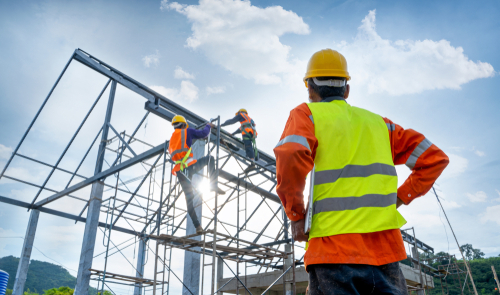The future of construction revolves around sustainability and long-lasting materials. This prevents waste and allows for the reuse of materials. In general, construction is extremely damaging to the environment, with the construction industry contributing to over 50% of landfill waste.

It is important to work with your climate to build a sustainable facility that features climate-resistant materials. It will help the environment, while also saving the facility from extra costs down the road.
We have curated a guide to the best tips, materials, and features for building a sustainable facility in your climate.
How to Build Greener
Building a new facility can accumulate unnecessary waste, extra power usage, and use up some of our most precious natural resources. A few ways to build greener include:
- Using recycled materials;
- Adding in renewable energy features;
- Ensuring your landscaping choice works with the environment;
- Minimizing foliage disruption while building; and
- Conducting soil stabilization at the building site.
Best Materials and Features for Each Climate
When building a new facility, it is best to take into account which materials will make the facility more efficient and last longer. This will save time and money, as well as the environment.
Desert Climate
Desert climates are characterized by a lack of water, high evaporation rates, and swinging temperatures. These are factors that help determine the type of building features and materials needed to build a facility able to withstand the elements. Here are some of the best desert-climate-resistant building materials:
- Metal roofing helps control indoor temperatures;
- Floors with a high thermal mass like tile or concrete are best for hot temperatures.;
- Solar panels are an environmentally friendly way to reduce utility costs;
- Vinyl windows are great for keeping the cool air in and the warm air out; and
- Adobe exteriors limit water absorption and reduce heat transfer.
Rainy Climate
Rainy climates bring high humidity and lush greenery. With high precipitation amounts, the risk of flooding, mold growth, and warped wood is increased. Here are some of the best materials and features for a rainy-climate-resistant facility:
- Engineered hardwood is more resistant to warping than traditional hardwood;
- Natural plasters retain and release moisture as needed;
- Metal or asphalt roofing will reduce mold and mildew buildup;
- Paperless drywall combats mold growth within your walls; and
- Vinyl siding prevents indoor flooding.
Cold Climate
Cold weather is pretty much inevitable in the United States, but some areas receive especially heavy snowfall, high wind speeds, and ice buildup for months on end. These areas have to be extra prepared for cold weather. Here are some of the best building materials and features for areas that experience frequent, extreme cold:
- Carpet will keep your facility warmer;
- Snow guards will prevent injury from falling snow;
- Composite wood or vinyl hand railings to prevent employees from slipping when coming up the steps;
- Multi-pane windows faced south to increase insulation and lower utility costs; and
- Heating tape can be attached to all pipes to prevent freezing and bursting.
Windy Climate
High-speed wind gusts, severe storms, and unpredictable weather patterns are all characteristics of a windy climate. Windy climates can be particularly destructive, which is why it is so important to use the following materials and features when building your facility in this climate:
- Concrete or steel parapet to help prevent roof uplift during a wind storm;
- Fiber cement siding is great for standing up against harsh impacts;
- Impact-resistant windows and doors to protect your facility from flying debris;
- Masonry blocks for walls to prevent damage from flying debris; and
- Steel framing will prevent your building from collapsing during high winds.
How to Prepare Your Facility for Climate Change
It is important to prepare your facility to survive and thrive in the ever-changing climate. This includes taking preventive measures to secure your facility, as well as measures to help prevent climate change itself. Here are a few steps you can take when building your new facility to prepare for and help prevent climate change:
- Bamboo or cork flooring is a sustainable alternative to traditional flooring;
- Cob-built facilities are known to reduce carbon footprint;
- Ferrock is a sustainable alternative to concrete;
- Low-flow toilets will lower your facility’s water usage;
- Mass timber is known for protecting against fires and reducing carbon emissions;
- Recycled plastic will help in soundproofing rooms in your facility;
- Recycled steel is used to save money and energy;
- Sheep wool insulation will warm your facility with reusable and non-toxic material;
- Straw insulation will keep your facility warm and reduce carbon emissions from burned straw; and
- Water recycling systems reuse sink water in other areas, such as the lawn.
Overall, when building a new facility, you must be aware of the climate struggles of the area as well as be prepared for a potential climate disaster. With climate disasters happening more often in some areas than others, it is best to take precautions into account when building a new facility. Taking steps to make your facility climate-resistant will help your wallet and the environment in the long run.
Lily Scott, a content creator living in New York City, wrote this article on behalf of insurance provider Hippo. When she isn’t creating exciting new content, she can be found snuggling with her cats or curating her online boutique.
